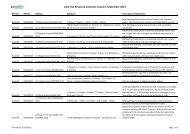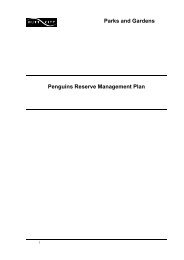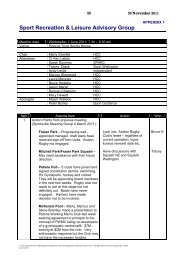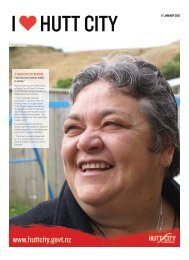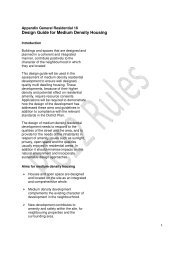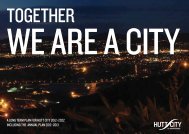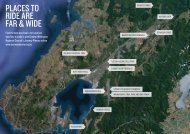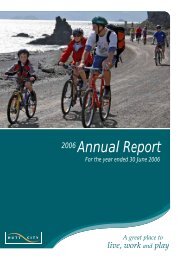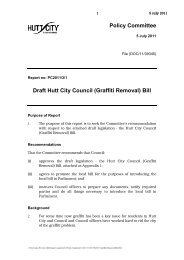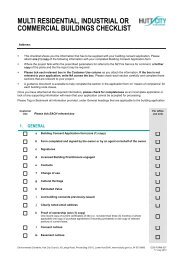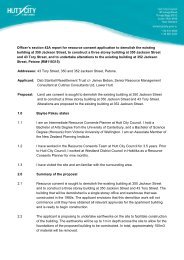Petone vision.pdf - Hutt City Council
Petone vision.pdf - Hutt City Council
Petone vision.pdf - Hutt City Council
You also want an ePaper? Increase the reach of your titles
YUMPU automatically turns print PDFs into web optimized ePapers that Google loves.
harbourand hillsheritageand historyvillagecultureeducationcentresustainabilitylocalgovernmentvibranta real placefamily-friendlydiversity<strong>Petone</strong><strong>vision</strong>statement
petone <strong>vision</strong> statement1Table of ContentsA ‘Vision’ for <strong>Petone</strong> 2The Vision Statement 3<strong>Petone</strong> Vision For 2027 4The Vision elements 4Vision Statement element 1: A distinguishing feature of <strong>Petone</strong>is it being a unique heritage placeVision Statement element 2: Growth in <strong>Petone</strong> will be managedin an economically and environmentally sustainable manner68Vision Statement element 3: A ‘real place’ for our people 12Vision Statement element 4: An attractive and vibrant villageculture at the heart of <strong>Petone</strong>14How the <strong>vision</strong> can be achieved 18Appendix 1: Map 22Appendix 2: History of the <strong>Petone</strong> area 24Appendix 3: Te Ati Awa people and <strong>Petone</strong> 26Appendix 4: How <strong>Petone</strong>’s communities are changing 28Appendix 5: Vision development process 36Appendix 6: Bibliography/reference material 38
petone <strong>vision</strong> statement2A ‘Vision’ for <strong>Petone</strong>:What will <strong>Petone</strong> be likeas a place to live andwork in 5 years time?In 20 years? And evenlonger term?The <strong>Petone</strong> Development Study seeks to shape and direct the answers to this question.A first step towards defining specific actions and investments needed for <strong>Petone</strong> is to develop a long term‘<strong>vision</strong>’ for the area.The <strong>Petone</strong> Development Study area includes the area from the foreshore to Wakefield Street and from the<strong>Hutt</strong> River to the top of the hill suburb of Korokoro.<strong>Petone</strong> is a strategic part of <strong>Hutt</strong> <strong>City</strong>. The unique blend of heritage buildings, small scale retailing, cafes,business opportunities and the foreshore add much to the overall fabric of the city. It is a gateway intothe urban area and is a vital link through it. In terms of population <strong>Petone</strong> comprises just under 10% of<strong>Hutt</strong> <strong>City</strong> and contributes significantly to the economy, to employment and to the vitality of the city.
The VisionStatementpetone <strong>vision</strong> statement3The <strong>vision</strong> statement comes from submission feedback,discussions and workshops with <strong>Petone</strong> residents andbusiness people. It consists of four elements. Eachelement is then further defined by a series of bullet pointswhich outline how each element can be achieved.Pages 6 to 17 then provide more detail on each of themajor elements of the Vision Statement and these areset out under:What the issues areFacts related to the elementFinally there is a section on how the elements in theVision can be addressed.
petone <strong>vision</strong> statement4<strong>Petone</strong>Vision for2027Element 1A distinguishing feature of<strong>Petone</strong> is it being a uniqueheritage place. This means:celebrating, preserving and promoting the heritageaspects that make <strong>Petone</strong>’s heritage and characterdistinctive; ensuring change is sympathetic and reinforces theheritage look and feel (in particular around JacksonStreet and adjoining streets); recognising the nature and scale of the urban fabricaround <strong>Petone</strong> and the residential areas surroundedby harbour, river, parks and hills; re-establishing and celebrating Iwi links to importantsites (taonga);protecting, and celebrating the heritage and cultural rootsof Maori and settlers;Element 2Growth in <strong>Petone</strong> will bemanaged in an economicallyand environmentallysustainable manner through:proactive management, planning and investment for<strong>Petone</strong>’s future prosperity;initiatives to address environmental qualities of<strong>Petone</strong>, including heritage;increased opportunity for residents to work locally;more local businesses working in a supportiveenvironment;increasing the attractiveness of walking, cycling andpublic transport options;sympathetically achieving a wider range of housingchoice;carefully managing any increasing population in <strong>Petone</strong>;supporting investment with attention to design qualitythat reinforces and enhances <strong>Petone</strong>’s character;changed roading networks that improve the movementof residential and business traffic and add amenityvalue to areas such as the foreshore.Element 3We recognise that <strong>Petone</strong>has to be a real place for ourpeople. This means:ensuring <strong>Petone</strong> is a safe community;encouraging diversity as a strength within aninclusive community;continuing to recognise and support the suburbof Korokoro and its contribution to <strong>Petone</strong>’soverall wellbeing;having a strong sense of community and continuingto meet local needs locally.
petone <strong>vision</strong> statement5Element 4<strong>Petone</strong> needs an attractiveand vibrant village cultureat its heart. This means:being recognised as family friendly;catering to changing needs and diversity within ourcommunity;enhancing and being encouraging of employment andbusiness as a key contributor to vibrancy;retaining small scale commercial activities and retailingas a defining feature of <strong>Petone</strong> and the Jackson Streetcharacter;developing a cultural heart to support creative arts;fostering quality design for all private property andpublic space development;engaging with the harbour, hills and river;recognising and supporting the important role oflearning institutions within <strong>Petone</strong>, including lifelong learning.Definingthe VisionelementsThe following sectionsexplain why variouselements have beenidentified for inclusionin the <strong>vision</strong> statement.
petone <strong>vision</strong> statement6VisionStatementelement 1:A distinguishingfeature of <strong>Petone</strong>is it being aunique heritageplace.1.1 achieved through:Celebrating, preserving and promoting theheritage aspects that make <strong>Petone</strong>’s heritageand character distinctive;There are issues because...<strong>Petone</strong> is very significant in New Zealand’shistory. Appendix 2 and 3 set this out. Stepshave been taken to celebrate and promotethis historical significance. There are viewsthat much more could and should be done.A parallel has been drawn to the reverenceand attention given to the ‘Mayflower’ landingsite at Plymouth in the U.S.A. and the tourismindustry surrounding this.the facts are...A range of community and council investmentsand initiatives have been undertaken around<strong>Petone</strong>’s heritage. For example, the SettlersMuseum, the water feature, heritage themestreet furniture and signposting in JacksonStreet. Further projects are possible, but willrequire funding through the Long Term <strong>Council</strong>Community Plan process. Other funding sourcesinclude community based fund raising, centralgovernment and private initiatives.1.2 achieved through:Ensuring change is sympathetic and reinforcesthe heritage look and feel (in particular aroundJackson Street and adjoining streets);There are issues because...<strong>Petone</strong> has uniqueness in relation to itsheritage character due to having wholeprecincts built in the same era. In manycases these precincts are largely intactand are seen as being something distinctiveand ‘marketable’.
petone <strong>vision</strong> statement7the facts are...The District Plan is a key tool for managingthe urban fabric of <strong>Petone</strong> through its policies,objectives, rules and land use zonings. At anational level recent legislative changes aroundthe concept of ‘historic heritage’ have theintention of strengthening and reinforcing theattention given to these aspects. At a grassroots level, community initiatives such as theJackson Street Programme can also play animportant role in raising awareness, tacklinglocal issues and identifying opportunities.1.3 achieved through:Recognising the nature and scale of the urbanfabric around <strong>Petone</strong> and the residential areassurrounded by harbour, river, parks and hills;There are issues because...While many residents say they welcomeinvestment into <strong>Petone</strong>, an underlying concernexists over whether sufficient safeguards arein place currently to ensure change in theurban fabric is sympathetic and in character.the facts are...Changes to the District Plan are possible, asis consideration of what resources are madeavailable for addressing quality design andheritage management.1.4 achieved through:Re-establishing and celebrating Iwi links toimportant sites (taonga);There are issues because...<strong>Petone</strong> is particularly significant to local Maori.Discussions with Te Ati Awa indicate that thereis considerable scope to ‘reconnect’ withimportant sites, particularly sites frontingthe harbour.the facts are...Te Ati Awa and the Wellington Tenths Trusthas interests in many sites throughout <strong>Petone</strong>,and wishes to contribute to the long termbetterment of the area.1.5 achieved through:Protecting, and celebrating the heritage andcultural roots of Maori and settlers.There are issues because...Both Maori and Settler history are definingelements of <strong>Petone</strong>, and there is a view thatmore needs to be done to highlight andcelebrate this history.the facts are...Settler history is supported in a range ofways already such as the database andother resources at the Settlers Museum.Further opportunities exist to develop tourismproducts around what <strong>Petone</strong> has to offer.
petone <strong>vision</strong> statement8VisionStatementelement 2:Growth in<strong>Petone</strong> will bemanaged in aneconomically andenvironmentallysustainablemanner2.1 achieved through:Proactive management, planning andinvestment for <strong>Petone</strong>’s future prosperity;There are issues because...Residents support a greater degree of attentionthrough decision making processes to thequality and ‘look and feel’ of changes happeningin <strong>Petone</strong>. A concern is that current qualitiesof <strong>Petone</strong> may be lost without a sufficientlyclear ‘game plan’ and supporting policies,objectives, rules and other methods to clarifywhat <strong>Petone</strong> could and should look like.the facts are...The main tools for <strong>Council</strong> decision makingand shaping investment in the <strong>Petone</strong> areaare the District Plan and Long Term <strong>Council</strong>Community Plan.2.2 achieved through:Initiatives to address environmental qualities of<strong>Petone</strong>, including heritage;There are issues because...Community awareness of environmentalsustainability issues is increasing and centralgovernment policy is encouraging greaterattention to issues such as climate change,and other environmental issues.the facts are...A combination of public sector, local communityand business responses are needed to makeprogress around sustainability issues.
petone <strong>vision</strong> statement92.3 achieved through:Increased opportunity for residents towork locally;There are issues because...A significant proportion of residents in thelabour force commute elsewhere to work.More people working and living locally wouldbe more sustainable both in terms of reducedtravel demand on congested motorways (andassociated costs), and through supportinglocal businesses, facilities and services.the facts are...Just over 60% of residents who are inthe workforce work locally in <strong>Petone</strong> (seeAppendix 4 for detail). Evidence from otherregions/suburbs suggests a figure of 70%could be feasible.2.4 achieved through:More local businesses working in asupportive environment;There are issues because...Local businesses cannot be taken for granted.There are increasing pressures arising fromcompetition from other centres, a currentlystatic population base, and increasing rentalsfor many businesses. Having a supportivelocal business environment can help reducethese challenges.the facts are...Local business numbers have been increasingslowly over the last 5 years. Property priceincreases have made parts of <strong>Petone</strong>attractive for relocation or redevelopmentwithin a regional context. Countering this arepressures on the retail sector with major retailfloorspace increases planned in centres suchas Johnsonville.Job numbers in <strong>Petone</strong> stand at around 7600,with a steady increase in the number ofbusinesses (see Appendix 4).2.5 achieved through:Increasing the attractiveness of walking,cycling and public transport options;There are issues because...Walking, cycling and public transport optionsoffer a range of sustainability (and health)benefits. They work best where land useplanning and development considers them asan integral part of decision making. There iscurrently potential for consideration of thesefactors, particularly in relation to the area nearthe <strong>Petone</strong> railway station.the facts are...Walking, cycling and public transport areregularly used by less than 10% of thepopulation currently. With much of the studyarea being flat there is good scope to increaseuse of these travel modes.
petone <strong>vision</strong> statement102.6 achieved through:Sympathetically achieving a wider range ofhousing choice;There are issues because...Changing population demographics within<strong>Petone</strong> and the wider Wellington regionsuggest there will be ongoing demand forhousing choices beyond those currentlyavailable in <strong>Petone</strong>. Medium density housingopportunities can help with sustainabilitygoals, however the challenge is to be ableto provide for housing of this type withoutdamaging the parts of <strong>Petone</strong> with goodheritage character.the facts are...Studies of housing demand in the Wellingtonregion indicate ongoing demand for mediumdensity housing (3 to 4 storey). Parts of<strong>Petone</strong> have characteristics such as accessto amenities and public transport that lendthemselves to conversion.2.7 achieved through:Carefully managing any increasing populationin <strong>Petone</strong>;the facts are...Household size in the study area averages2.5 persons per household, slightly below the<strong>Hutt</strong> <strong>City</strong> and overall New Zealand figure of2.7. Projections from Statistics New Zealandare for these figures to continue to reduce asthe population ages – the consequence beingthat a population decrease is a possibility.2.8 achieved through:Supporting investment with attention todesign quality that reinforces and enhances<strong>Petone</strong>’s character;There are issues because...Residents and investors alike seek greaterclarity around where and what urban changecan occur. Attention to design quality andrecognising that <strong>Petone</strong>’s heritage characterare key factors.the facts are...A range of methods could be put in placeto address the issues raised around qualitydesign and locations where change can bebetter accommodated.There are issues because...There is a challenge between needing morepeople to sustain <strong>Petone</strong> and its businessesto keep it vibrant, and how housing needsand opportunities are managed. Populationgrowth for <strong>Petone</strong> is not guaranteed due topopulation ageing and migration trends. In theperiod 1991 to 1996 the population of <strong>Petone</strong>declined slightly.
petone <strong>vision</strong> statement112.9 achieved through:Changed roading networks that improvemovement of residential and business trafficand add amenity value to areas such asthe foreshore;There are issues because...Traffic on the Esplanade is heavy and notsustainable economically or environmentallyinto the future. It also decreases the amenityvalue of the Esplanade for recreational uses.the facts are...<strong>Petone</strong> Esplanade traffic flows are someof the highest for heavy vehicles withinNew Zealand. The average traffic flow is28,000 vehicles per day with up to 9% ofthat flow being heavy commercial vehicles.<strong>Hutt</strong> <strong>City</strong> <strong>Council</strong> has included $18 millionin its Long Term <strong>Council</strong> Community Planof the $60 million estimated to undertakethe Cross Valley Link. Upgrading workson the Esplanade itself are currentlyunbudgeted and estimated to be of theorder of $5 million plus.
petone <strong>vision</strong> statement12VisionStatementelement 3:A ‘real place’for our people3.1 achieved through:Ensuring <strong>Petone</strong> is a safe community;There are issues because...People generally perceive <strong>Petone</strong> as a good,safe place to live and work although residentsseek an even greater focus on safety. Ensuringthat urban design, layout, and investmentsin lighting and other safety improvementsreinforce and strengthen this perception isseen as making <strong>Petone</strong> even more attractive.the facts are...<strong>Petone</strong>’s safety statistics are in keeping withnational averages around traffic accidentsand reported crime.3.2 achieved through:Encouraging diversity as a strength in aninclusive community;There are issues because...Residents see the people aspect of <strong>Petone</strong>as something special. They value the fact that<strong>Petone</strong> is the home to a diverse cross sectionof the population. While being supportive ofupgrading and improvements in the look andfeel of <strong>Petone</strong>, there is a concern that thisdiversity isn’t lost or displaced. Feedback hasbeen that while <strong>Petone</strong> needs to seek to beprosperous, it should not do so by pushing outthe less well off.the facts are...The perception of <strong>Petone</strong> as a diversecommunity is confirmed by census datashowing a cross section of ethnicity, incomes,and age profiles (see Appendix 4).
petone <strong>vision</strong> statement14VisionStatementelement 4:An attractiveand vibrantvillage cultureat the heartof <strong>Petone</strong>4.1 this meansCatering to changing needs and diversitywithin our community;There are issues because...<strong>Petone</strong> residents have commented that theworking class roots and mix of residentsprovide a special aspect of the place thatneeds to be retained. While welcoming wellmanaged upgrading and investment in <strong>Petone</strong>,there is a concern not to ‘push out’ the lesswell off.the facts are...Statistics show that the likely future makeupof households is changing in terms of averagesize of households (getting smaller), ageingresidents, the type of housing choices beinglooked at (more singles and couples), and issuesaround affordability. Keeping <strong>Petone</strong> attractivefor these groups will also be important.4.2 This meansBeing recognised as family friendly;There are issues because...Families add vitality and vibrancy to <strong>Petone</strong>,and are an element that must not be takenfor granted.the facts are...Current demographic projections suggestthat with an ageing population profile (seeAppendix 4) some of the vitality and vibrancyof <strong>Petone</strong> may be lost if attention is not givento ensuring the place is attractive to families.
petone <strong>vision</strong> statement154.3 this meansEnhancing and being encouraging ofemployment and business;There are issues because...Vitality and vibrancy are affected by the strengthof employment and business opportunity in acommunity. There is recognition that variouspressures exist on some businesses, particularlysmall scale retailers. Business must remain onthe front foot.the facts are...Statistics tracking employment and businessvitality at a local level are difficult to access.There is information on business rents andfigures available on competition (in termsof new or upgraded floorspace) from othercentres. Sufficient evidence exists to confirmsmall scale retailers and some commercialoperations are under pressure. Overallhowever business employment growth hasbeen improving. The issue requires a sectorspecific assessment.4.4 this meansRetaining small scale commercial activitiesand retailing as a defining feature of <strong>Petone</strong>’sand Jackson Street’s character;There are issues because...A defining feature of <strong>Petone</strong> is seen to bethe character and convenience offered bysmall scale commercial activity and retailing,particularly along and around Jackson Street.In the face of competition from large formatretailers, and with extensions of other centresplanned, this existing character could comeunder pressure.the facts are...Retaining small scale commercial activitiesand retailing in and around Jackson Streetin particular is canvassed in 4.3. Commercialrental figures for Jackson Street show increases.In 2002 rentals were between $150 and$180 per square metre (psm). Currently theyare between $260 and $300 psm. These aresimilar to those in centres such as Newtownin Wellington <strong>City</strong>, and are a half to a thirdless than locations such as Cuba Street inWellington (source: Bayleys Real Estate).
petone <strong>vision</strong> statement164.5 this meansDeveloping a cultural heart to supportcreative arts;There are issues because...<strong>Petone</strong> is seen as having untapped creativepotential that could be harnessed andshowcased as an attraction in its own right.There is a perception that <strong>Petone</strong> currentlylacks a cultural heart.the facts are...Figures are available from the businessdirectory on businesses involved in the‘creative industries’ and services howeverno assessment has been undertaken ofthese to date.4.6 this meansFostering quality design for all private propertyand public space development;4.7 this meansEngaging with the harbour, hills and river;There are issues because...More should be done to face and betterconnect with the harbour and river.Considerable opportunities to augment theexperience on the foreshore and river areseen. A key consideration relates to the roleof the Esplanade and whether the cross-valleylink road is established.the facts are...The HCC Coastal Management Studyfrom 1991 contains good base informationwhich still has relevance to issues raisedthrough the <strong>Petone</strong> Vision workshops. A keyaspect in strengthening the connection to theharbour is the decision on the cross-valleylink road and associated improvements whichwould significantly reduce traffic pressureon the Esplanade.There are issues because...A theme emerging time and time againthrough consultation is around havingmore sophisticated systems for addressingthe design quality and ‘fit’ of developmentsin both the private and public sectors.Systems and processes used elsewhere inNew Zealand were pointed to as examples.the facts are...Quality design assessment work has beenstarted with previous evaluations of JacksonStreet and its environs. A NZ Urban DesignProtocol exists and all the metropolitan councilsin the Wellington area have signed up to this.A variety of design guidelines and relatedmechanisms are in operation elsewhere in N.Z.and have relevance in the <strong>Petone</strong> context.
petone <strong>vision</strong> statement174.8 this meansRecognising and supporting the important roleof learning institutions within <strong>Petone</strong>, includinglife long learning;There are issues because...The role of learning institutions within <strong>Petone</strong>is recognised as very important to <strong>Petone</strong>’sfuture and a defining feature, particularly withregard to WelTec. They are a key employerin <strong>Petone</strong> and with nearly 7000 studentsenrolled, adding diversity and money to thelocal economy. There are also importantlinkages with businesses in the area.the facts are...Means of supporting life long learning and therole of learning institutions within <strong>Petone</strong> havebeen initiated already by the <strong>Council</strong>, andfurther work on the detail of possible actionscould follow in the later stages of the <strong>Petone</strong>Development Study.In 2007 WelTec has enrolled some 6949 people.This equates to 3276 equivalent full timestudents.
petone <strong>vision</strong> statement18How canthe <strong>Petone</strong>Vision beachieved?The intent of this Vision document is to set out communityexpectations and aspirations, as far as possible, on thefuture development of <strong>Petone</strong>. The <strong>vision</strong> document itselfhas no statutory effect, but will become the basis forother documents, plans and strategies that will. Changeswill ultimately be incorporated into the District Plan, theLong Term <strong>Council</strong> Community Plan, Asset ManagementPlans and Local and Regional Land Transport Plans andstrategies, to give effect to the <strong>vision</strong>.There are actions that would support this Vision and thereare organisations and groups in the community well placedto help.These goups and organisations include:Community Groups formed for the purposes ofpromotion and enhancement of issues such as communitywellbeing, education, sustainability, heritage, culturalpursuits, ethnic affairs, recreation, hobbies and pastimesand other aspects of life in the <strong>Petone</strong> community.Local Government which includes the <strong>Hutt</strong> <strong>City</strong> <strong>Council</strong>,the <strong>Petone</strong> Community Board and Greater Wellington, theRegional <strong>Council</strong>.Business and local business groups including theJackson St Programme, other associations like Business<strong>Hutt</strong> Valley and Rotary and local businesses operatingin <strong>Petone</strong>.Investors and potential investors in commercialundertakings and property development.Educational Institutions like Weltec and other NZQAaccredited course providers.Iwi in terms of pre and post European settlement heritage,social and economic issues, along with cultural andartistic aspects.Some of the actions that support theachievement of the <strong>vision</strong> with theinvolvement of these groups are:For community groupsprimarily:Concentrate on the development of <strong>Petone</strong> as aninclusive community for new residents in particular, butalso for some socio-economic groups who may feelthreatened by change and their perceptions of it.Take a lead role in promoting and maintaining <strong>Petone</strong>as a safe and caring community.Promote local heroes in all aspects of community life,by recognising and supporting pride in the communityfor local achievements.Define and promote the idea of a cultural heart.Promote the heritage aspects of <strong>Petone</strong> to make itdistinctive in the city and the region.For local governmentprimarily:Co-ordinate, review and adjust the various plans andstrategies as they apply to the <strong>vision</strong>. This may includealigning the District Plan, the Long Term <strong>Council</strong>Community Plan, Land Transport Strategies, ReserveManagement Plans and Asset Management Plans.Develop appropriate pro<strong>vision</strong>s in the District Plandirectly related to issues raised in the <strong>vision</strong>, whichcould for example cover mixed use developmentissues, design guidelines for new developments andre-developments and heritage protection for buildingsand localities.Pursue opportunities to plan for and establishthe Cross Valley Link, along with plans for theenhancement of the Esplanade, building on thephysical and design based connections between theforeshore and the developments around Jackson St.
petone <strong>vision</strong> statement19Raise the profile of cycling, walking and publictransport, as sustainable and environmentallyeffective transport modes.Promote <strong>Petone</strong> as a place to establish and operatea business including the benefits of a local workforceand easy access for staff.Establish a fast and cost competitive broadbandnetwork throughout <strong>Petone</strong> (and therest of the city) for business and residential use.For business groups andlocal businesses primarily:Seek to provide economic benefits through increasingemployment opportunities.Support mentoring for new and expanding businesses.Promote the advantages of working locally andsupport programmes to buy locally.For investors and potentialinvestors primarily:Consider the pro<strong>vision</strong> of different housing types andstyles that can better meet needs in a changing socialand demographic climate.Develop forms of housing accommodation that canform part of mixed use developments.Accept that in some parts of <strong>Petone</strong> sympatheticrefurbishment will be preferred to wholesaleredevelopment.Encourage a focus on quality design and integrationinto the urban fabric.For educational providersprimarily:Develop and reinforce the role of education in thesocial and economic life of the community.Gain community support for the benefits of a studentpopulation as part of life in the community, particularlyits vibrancy.Publicise the flow-on effects of local educationproviders for the business community.Promote and provide for life long learningopportunities.Work with local businesses to provide skills andlearning which assist growth.For Iwi primarily:Highlight and promote the unique activities andinterests of local Maori in the early and settler history.Assist in gaining community recognition of the socialand economic issues facing Maori in the community.Document and refine information about sites andlocalities of social, economic and cultural importanceto local Iwi.Progress prospects celebrating Iwi links to the area.While the <strong>Council</strong> has promoted this process, withoutcommunity support nothing will be achieved. No singleagency, group or organisation will successfully accomplishany of these things. Working together to an agreed <strong>vision</strong>will go a long way towards achieving results.
petone <strong>vision</strong> statement20<strong>Petone</strong>VisionStatementAppendices
petone <strong>vision</strong> statement22Appendix One:
Appendix 1petone <strong>vision</strong> statement23
petone <strong>vision</strong> statement24Appendix Two:History of the<strong>Petone</strong> areaMaori settlement in the valley is traditionally dated backto A.D. 1250, when the two sons of Whatonga, a Hawke’sBay chief, settled in the area. Maori called the riverHeretaunga, after their old home. Te Puni establishedhis people at Pito-one and Te Wharepouri at Ngaurangaaround 1832.The name “<strong>Hutt</strong>” was bestowed by Colonel Wakefieldoriginally on the Heretaunga River. Gradually it spread tothe valley and the names “Lower <strong>Hutt</strong>” and “Upper <strong>Hutt</strong>”came into use. Sir William <strong>Hutt</strong> was a prominent directorand one-time chairman of the New Zealand Company.<strong>Petone</strong>’s name is derived from “Pito-One” which means“End of Sands”.The lower part of the valley was significant in a nationalcontext for its concentrated industrial base in the late19th and early 20th century.In the post-war period Lower <strong>Hutt</strong> was at the forefrontof the Modern Movement architecture in New Zealand.Housing and commercial developments in the <strong>Hutt</strong> Valleyenabled some of New Zealand’s leading architects to fullyexplore town planning and functional design which werekey elements of the Modern Movement.<strong>Petone</strong> within the <strong>Hutt</strong><strong>Petone</strong> has evolved from its historically significantbeginnings (as the first site of organised Europeansettlement in New Zealand), to become a vibrantcommunity, renowned for its café culture andexpansive foreshore.Set out below is a timeline of some of the key milestonesfor <strong>Petone</strong>.In 1839 the preliminary expedition of the New ZealandCompany arrived in the Tory, under Colonel WilliamWakefield, who bought land for new settlement fromNgati Awa.January 1840 saw the arrival of “Cuba” and the firstsurvey of Britannia (an early name for the area). Thefirst settlers landed on the beach at <strong>Petone</strong> from the“Aurora” and started to clear the land and make theirhomes in the lower valley with help from Ngati Awa.Within a few months, however, flooding of the riverdrove most of the colonists to the southern end of theharbour (Thorndon and Te Aro), while a few remainedbehind in <strong>Petone</strong> and Lower <strong>Hutt</strong>.The <strong>Hutt</strong> Road linking Wellington to <strong>Petone</strong> wascompleted in 1841.The following year was significant with the death ofTe Wharepouri.In 1846 there was conflict between settlers and Maoriwhich led to skirmishes.The first flour mill was built at Korokoro by J. H. &J. Percy in 1851.In 1855 a major earthquake raised part of the lowervalley by 2 metres, allowing land to be reclaimedfrom swamp.The year 1870 saw the death of Te Puni. A Statefuneral was held in his honour on December 9th.The settlers found the greater part of the valleycovered with forest. The timber trade was important inthe first half century of the valley’s growth, and manysawmills operated in this period. As land was clearedand roads were constructed, farming became themain activity, with the valley increasingly supplyingthe needs of the nearby capital city of Wellington.For <strong>Petone</strong> the official opening of the railway northfrom Wellington to <strong>Petone</strong> in 1874 and the subsequentlocation of the railway’s engineering works at <strong>Petone</strong>built in 1878 to 1879 led to a rapid expansion of thearea’s population and economy. Other businesses andindustries were soon attracted to the district, includingthe first Post Office established in Johnson’s store onthe <strong>Hutt</strong> Road.The <strong>Petone</strong> School opened in February 1882, with theMarine Retreat Hotel (Grand National), and Gear MeatPreserving and Freezing Coy.The year 1882 was also significant as the first meetingof the <strong>Petone</strong> Town Board occurred on 15th December.
Appendix 2petone <strong>vision</strong> statement25<strong>Petone</strong> was proclaimed a Borough in July 1888.The first substantial <strong>Petone</strong> wharf was built in 1883– 1884 for the Gear Meat Company.The foundation stone of <strong>Petone</strong> Woollen Mills was laidby Premier Stout in 1885.In 1887 the first issue of the <strong>Hutt</strong> & <strong>Petone</strong> Chroniclewas published in August. That same month sawthe <strong>Petone</strong> Working Men’s Club chartered in Peel’sBuildings in Jackson Street.A fire station was build in Sydney Street in 1892.Edwin Jackson whose name graces Jackson Streetdied in April 1896.A permanent post office was built in Jackson Streetin 1899. May of that year saw the opening of themunicipal gasworks. In August sections were open forselection for the Korokoro Village Settlements.<strong>Petone</strong> Technical School was established in 1904.July of 1905 saw the opening of the the third <strong>Petone</strong>Railway Station.In 1906 the first of the Patrick Street houses wherecompleted. This was the site of the first state housingventure in New Zealand. In all 25 houses were builtusing seven different designs.1906 also saw the opening of a new municipal buildingin Jackson Street.A replacement <strong>Petone</strong> wharf was built in 1907.<strong>Petone</strong> West school (closed in 1983) was openedin 1909.A major industrial undertaking opened in 1919 with thebuilding of the Lever Brothers soap factory.The first electric street lights were turned on in theborough in December 1924.The year 1926 was significant as it saw <strong>Hutt</strong> ValleyHigh School formed with the merging of <strong>Petone</strong> and<strong>Hutt</strong> District High Schools. This was also the same yearthat the General Motors plants opened, along with theN.Z. Motor Bodies plant and the C. S. Odlins plant.The Wilford School opened in 1927 with a roll of 141.In 1928 to 1929 the Railway Workshops moved toWoburn.The following year saw the opening of the W. D. &H. O. Wills Tobacco plant.In 1933 the McKenzie Baths were officially opened.Todd Motor Industries opened their premises in 1935.The State Theatre was built in 1937.With the jubilee of the Borough in 1939 a newgrandstand was built in the <strong>Petone</strong> Recreation Ground.The Centennial Memorial was opened on the foreshorein January of 1940.An electric suburban rail service was inaugurated onthe <strong>Hutt</strong> line in 1953.The following year in 1954 the new estuary bridgeopened.In 1977 the <strong>Petone</strong> Settlers’ Museum was opened onthe foreshore in the Centennial Memorial building.New borough council chambers and library wereopened in Britannia Street in 1985.In 1987 IBM opened a new complex on the formerGear Meat Company site.The year 1988 marked the centennial of <strong>Petone</strong>Borough.The following year of 1989 saw amalgamation withLower <strong>Hutt</strong> <strong>City</strong>.The sesqui-centenary of the first European settlerswas held in 1990 on <strong>Petone</strong> Beach.The Jackson Street programme aimed at promotingand rejuvenating Jackson Street began in 1991.
petone <strong>vision</strong> statementTe Puni’s pa at <strong>Petone</strong>, 1847This sketch of the <strong>Petone</strong> area showsat right the palisade of a pa establishedby the Te Ati Awa leader Te Puni.When he and other Te Ati Awa peoplefrom Ngamotu in Taranaki arrived atWaikanae in 1832, they were invited tosettle at <strong>Petone</strong>, on Wellington Harbour,with some of their Ngati Mutunga kin.26Appendix Three:Te Ati Awa peopleand <strong>Petone</strong>After their journey from Taranaki, Te Ati Awa people fromNgamotu settled first at Waikanae.The hapu (sub-tribe) Te Mana of Ngati Mutunga wereliving at Pito-one (<strong>Petone</strong>) just north of Wellington, havingarrived in a previous migration from Taranaki. They invitedthe Ngamotu chiefs Te Puni, Te Wharepouri, Te Matangiand his son Te Manihera Te Toru to settle with them there,since they were close kin.About the same time, the Te Ati Awa leader Wi Tako Ngatataand a war party were returning south. They made theirway to Heretaunga (the <strong>Hutt</strong> Valley) and attacked theNgati Kahukura-awhitia settlement called Puniunuku.Their aim was to avenge the death of the Ngati Mutungachief, Te Momi. In gratitude Patukawenga of Ngati Mutungamade Waiwhetu, the area east of the Heretaunga (<strong>Hutt</strong>)River mouth, tapu (sacred) for the Ngamotu people.Patukawenga called this area Te Iwi Tuara o Tipi (thebackbone of Tipi) after his cousin, who had been given inmarriage to a Ngamotu chief. The Te Mana people thenmade Whiorau (Lowry Bay) tapu for the Ngamotu people.These gifts gave Te Ati Awa a stake in the Wellington region.The Paukena migrationTe Puni and Te Wharepouri took a war party to theWairarapa, seeking revenge for an incident in which somepeople had been killed, but they arrived to find the landdeserted. They decided to take most of their people tosouthern Wairarapa, leaving the older ones at Waiwhetu.While the Ngamotu people were in the Wairarapa, thesituation along the Kapiti coast had deteriorated becauseof pressures on land, and old rivalries. Haowhenua, along-running and inconclusive battle in 1834, saw anotherTaranaki migration, known as Paukena, arrive from Waitara.These Te Ati Awa people were led by Te Rangitake (alsoknown as Wiremu Kingi).The 1835 transferIn 1835 Ngati Mutunga and sections of Ngati Tama, feelinginsecure about the arrival of Ngati Raukawa on the Kapiticoast and the breakdown of relationships with Ngati Toaafter the Haowhenua battle, sought to escape the growingpressures. They were aware of the resources of theChatham Islands and planned to seize a ship, the Rodney,to take them to the Chathams from Matiu (Somes Island)in Wellington Harbour.Before the final voyage in November 1835, at a meetingon Somes Island, Ngati Mutunga transferred their rightsto land around the harbour to Te Ati Awa and otherTaranaki chiefs.The battle called KuititangaFought in October 1839, the battle known as Kuititangawas the last major tribal war over land before the arrivalof New Zealand Company settlers at Port Nicholson.Some Ngati Raukawa people, with the blessing of theNgati Toa leader Te Rauparaha, attacked Te Ati Awa atWaikanae. The ostensible reason was the ill treatment byNgati Tama of Te Rauparaha’s sister Waitohi. She died justbefore the battle. However, the real reason for the fightingwas competition for land and resources. The people ofNgati Raukawa expected to win, but had more casualtiesthan Te Ati Awa, who saw this battle as a victory. Thebattle of Kuititanga clarified issues of land ownership,particularly on the Kapiti coast.Settler pressuresIn 1839 the New Zealand Company, set up to organiseemigration from England, bought land in the WellingtonHarbour area for settlement. (The validity of this purchasewas later disputed.)The following year, English immigrants began arriving bythe shipload, and the demand for land and pressure onthe areas occupied by Maori pa and settlements steadilyincreased. The New Zealand Company had sold sectionsalready occupied by Maori to the new settlers. To resolvethis issue, Lieutenant Colonel William Anson McCleverty
Appendix 3petone <strong>vision</strong> statement27was appointed to obtain deeds from the tribes concerned,exchanging their settlements and cultivations for landelsewhere.The McCleverty awards of 1847 were the final allocationof lands for Maori in the Wellington Harbour area. Pasuch as Te Aro, Pipitea and Kaiwharawhara became lessdesirable as their food-growing areas were replaced byless productive and more remote land, mostly outside thetown of Wellington. The pressure on the Te Aro peoplewas such that by 1881, a census showed only 28 Maoristill living at Te Aro, and nine at Pipitea.Maori departuresWith the threat of European settlers also encroaching onancestral lands in Taranaki, return migrations took place.About 600 Te Ati Awa went back to Taranaki in 1848.More Maori returned to Taranaki as a consequence ofthe land wars there in the 1860s. The Te Ati Awa subtribeTe Matehou, of Pipitea pa, moved to join their kin atWaiwhetu. Ngati Tama also moved away, with those inOhariu migrating to Whakapuaka near Nelson. Those leftto keep the fires burning in Wellington after about 1890belonged predominantly to the Te Ati Awa sub-tribes ofNgati Te Whiti, Te Matehou, Ngati Tawhirikura and NgatiPuketapu. This remains the situation today.The disappearance of pasitesThe pressures of European settlement led to thedisappearance of many traditional pa. By the 1890s sitesat both Te Aro and Pipitea were unoccupied; Pito-one(<strong>Petone</strong>) pa was abandoned soon afterwards, althoughthe Te Puni street cemetery remains in use.Recent timesTe Ati Awa in Wellington retained strong ties with theirTaranaki relatives. Between the two world wars TaranakiMaori began migrating to Wellington once again, oftenlooking for work.The growing numbers of Te Ati Awa in the <strong>Hutt</strong> Valley ledto the opening in 1933 of the meeting house Te Tatau oTe Pa. During and after the Second World War even largernumbers of Maori, not all Te Ati Awa, were attracted toWellington by employment opportunities.The Wellington TenthsIn 1839 the New Zealand Company purchased landaround Wellington Harbour from some of the Maori whohad customary rights there. The purchase deed providedfor one-tenth of the land purchased to be reserved for thesignatory chiefs and their families. This pro<strong>vision</strong> gave riseto the expression ‘tenths’, to refer to the land reserved forMaori in and around Wellington.In 1960 the Waiwhetu marae at Lower <strong>Hutt</strong> was opened.And in 1977 the Wellington Tenths Trust was establishedto represent the beneficiaries of the Wellington landreserves (‘tenths’).These beneficiaries are the descendants of Te Ati Awa andother Taranaki people who were living in the WellingtonHarbour area at the time of the disputed New ZealandCompany purchase in 1839. The trust has since pursuedclaims with the Waitangi Tribunal to gain compensation forthe losses suffered since 1839.Source: http://www.teara.govt.nz/The pa at Ngauranga also declined and did not surviveinto the 20th century.Waiwhetu pa was the last Maori-owned settlement inthe 1920s in the Lower <strong>Hutt</strong> region. However, it waseventually overtaken by river works and developments.Its site is now marked by the cemetery, Owhiti, near themouth of the Waiwhetu Stream. Only the seasonal pa atOrongorongo and Parangarehu remained in use.
petone <strong>vision</strong> statement28Appendix Four:How <strong>Petone</strong>’s communities are changingTo help inform the discussion on a <strong>vision</strong> for <strong>Petone</strong> it is important to understand its population and business makeup.Comparisons between 1996 to the latest census figures in 2006 are provided where this information is available. Somedetailed 2006 census data is still not available.Population changeArea Unit1996 CensusUsuallyResidentPopulationCount2001 CensusUsuallyResidentPopulationCount2006 CensusUsuallyResidentPopulationCountChange1996 to 2006PopulationCount% change1996 to 2006Population569800 Korokoro 1,266 1,269 1,287 21 2%569900 <strong>Petone</strong> Central 894 843 879 -15 -2%570000 Esplanade 2,445 2,436 2,361 -84 -3%570100 Wilford 3,390 3,486 3,369 -21 -1%<strong>Petone</strong> Study Area Total 7,995 8,034 7,896 -99 -1%<strong>Hutt</strong> <strong>City</strong> 95,874 95,490 97,701 1,827 2%Wellington Region 414,048 423,768 448,959 34,911 8%Change in numbers of householdsArea Unit1996 OccupiedDwelling Count2001 OccupiedDwelling Count2006 OccupiedDwelling CountChange1996 to 2006OccupiedDwelling Count% change1996 to 2006OccupiedDwellings569800 Korokoro 483 492 510 27 6%569900 <strong>Petone</strong> Central 345 336 336 -9 -3%570000 Esplanade 963 966 966 3 0%570100 Wilford 1,320 1,353 1,341 21 2%<strong>Petone</strong> Study Area Total 3,111 3,147 3,153 42 1%<strong>Hutt</strong> <strong>City</strong> 34,140 34,668 35,727 1,587 5%Wellington Region 150,138 157,914 169,344 19,206 13%
Appendix 4petone <strong>vision</strong> statementPopulation age projections for <strong>Hutt</strong> <strong>City</strong>29Year Age Groups MediumProjection Total0-14 15-39 40-64 65+2001 23,800 36,000 29,000 10,200 99,0002006 23,200 35,100 32,100 11,000 101,4002011 22,100 33,300 34,600 12,100 102,1002016 20,600 32,400 35,000 14,300 102,3002021 19,200 32,000 34,400 16,400 102,0002026 18,400 31,300 32,400 19,300 101,400Ethnicity data 2006EuropeanEthnicGroupsMaoriEthnicGroupPacificPeoplesEthnicGroupsAsianEthnicGroupsMiddleEastern,LatinAmericanandAfricanEthnicGroupsOtherEthnicGroupsTotalPeople569800 Korokoro 960 75 33 69 6 204 1,248569900 <strong>Petone</strong>Central570000Esplanade531 186 75 87 0 108 8641,452 420 327 192 12 228 2,319570100 Wilford 2,049 537 375 414 18 336 3,297<strong>Petone</strong> StudyArea Total4,032 1,143 777 693 30 672 6,480Lower <strong>Hutt</strong> <strong>City</strong> 61,896 16,281 10,095 8,361 1,059 9,618 95,421New Zealand 2,609,589 565,329 265,974 354,549 34,743 430,881 3,860,163569800 Korokoro 76.9% 6.0% 2.6% 5.5% 0.5% 16.3%569900 <strong>Petone</strong>Central570000Esplanade61.5% 21.5% 8.7% 10.1% 0.0% 12.5%62.6% 18.1% 14.1% 8.3% 0.5% 9.8%570100 Wilford 62.1% 16.3% 11.4% 12.6% 0.5% 10.2%<strong>Petone</strong> StudyArea Total62.2% 17.6% 12.0% 10.7% 0.5% 10.4%Lower <strong>Hutt</strong> <strong>City</strong> 64.9% 17.1% 10.6% 8.8% 1.1% 10.1%New Zealand 67.6% 14.6% 6.9% 9.2% 0.9% 11.2%Source: Statistics New Zealand Census 2006 (note totals add up to more than 100% due to multiple ethnicities reported).
petone <strong>vision</strong> statement30Detailed age profile 2006Area Unit 0-4Years5-9Years10-14Years15-19Years20-24Years25-44Years45-64Years65+YearsTotal569800 Korokoro 69 66 84 99 69 426 375 96 1,284569900 <strong>Petone</strong>Central69 60 42 48 87 375 159 39 879570000 Esplanade 189 144 114 123 195 819 516 261 2,361570100 Wilford 240 222 198 240 267 1,098 762 345 3,369<strong>Petone</strong> Study AreaTotal498 426 354 411 549 2,292 1,437 645 6,609<strong>Hutt</strong> <strong>City</strong> 7,419 7,344 7,584 7,434 5,982 28,398 22,899 10,638 97,704569800 Korokoro 5.4% 5.1% 6.5% 7.7% 5.4% 33.2% 29.2% 7.5% 100%569900 <strong>Petone</strong>Central7.8% 6.8% 4.8% 5.5% 9.9% 42.7% 18.1% 4.4% 100%570000 Esplanade 8.0% 6.1% 4.8% 5.2% 8.3% 34.7% 21.9% 11.1% 100%570100 Wilford 7.1% 6.6% 5.9% 7.1% 7.9% 32.6% 22.6% 10.2% 100%<strong>Petone</strong> Study AreaTotal7.5% 6.4% 5.4% 6.2% 8.3% 34.7% 21.7% 9.8% 100%<strong>Hutt</strong> <strong>City</strong> 7.6% 7.5% 7.8% 7.6% 6.1% 29.1% 23.4% 10.9% 100%Source: Statistics New Zealand Census 2006
Appendix 4petone <strong>vision</strong> statementLabour force status 2006 (usually resident populationaged 15 years and over)31EmployedFull-timeEmployedPart-timeUnemployedNot in theLabour ForceWork andLabourForce StatusUnidentifiableTotal569800 Korokoro 630 186 33 192 18 1,062569900 <strong>Petone</strong> Central 459 75 30 129 9 705570000 Esplanade 1,065 237 75 516 24 1,914570100 Wilford 1,455 366 114 738 42 2,712<strong>Petone</strong> Study AreaTotal 2,979 678 219 1,383 75 5,331Lower <strong>Hutt</strong> <strong>City</strong> 39,063 10,335 2,988 21,795 1,167 75,354New Zealand 1,531,020 454,758 106,497 961,788 106,308 3,160,374569800 Korokoro 59.3% 17.5% 3.1% 18.1% 1.7% 100%569900 <strong>Petone</strong> Central 65.1% 10.6% 4.3% 18.3% 1.3% 100%570000 Esplanade 55.6% 12.4% 3.9% 27.0% 1.3% 100%570100 Wilford 53.7% 13.5% 4.2% 27.2% 1.5% 100%<strong>Petone</strong> Study AreaTotal 55.9% 12.7% 4.1% 25.9% 1.4% 100%Lower <strong>Hutt</strong> <strong>City</strong> 51.8% 13.7% 4.0% 28.9% 1.5% 100%New Zealand 48.4% 14.4% 3.4% 30.4% 3.4% 100%Source: Statistics New Zealand Census 2006
45%40%petone <strong>vision</strong> statement32Age profile 200635%30%Percentage25%20%15%10%5%0%0-4Years5-9Years10-14Years15-19Years20-24Years25-44Years45-64Years65+YearsAge Group569800 Korokoro569900 <strong>Petone</strong> Central570000 Esplanade570100 Wilford<strong>Petone</strong> Study Area Total<strong>Hutt</strong> <strong>City</strong>Numbers relate to Census Area Units
Place of work in 2001WorkplaceAreaTotalworkplacepopulationLower<strong>Hutt</strong> <strong>City</strong>KapitiCoastPorirua<strong>City</strong>Usual ResidenceUpper<strong>Hutt</strong> <strong>City</strong>Wellington<strong>City</strong>WairarapaRemainderof NZAppendix 4petone <strong>vision</strong> statement33569800 Korokoro 459 288 12 36 39 75 3 9569900 <strong>Petone</strong>Central 4,704 2,730 144 297 483 948 51 54570000Esplanade 1,365 882 33 69 150 195 24 18570100 Wilford 1,041 693 21 42 99 159 6 15<strong>Petone</strong> StudyArea Total 7,569 4,593 210 444 771 1,377 84 96<strong>Hutt</strong> <strong>City</strong> 35,508 24,021 714 1,470 3,570 4,980 336 414569800 Korokoro 100% 62.3% 2.6% 7.8% 8.4% 16.2% 0.6% 1.9%569900 <strong>Petone</strong>Central 100% 58.0% 3.1% 6.3% 10.3% 20.1% 1.1% 1.1%570000Esplanade 100% 64.3% 2.4% 5.0% 10.9% 14.2% 1.8% 1.3%570100 Wilford 100% 67.0% 2.0% 4.1% 9.6% 15.4% 0.6% 1.4%<strong>Petone</strong> StudyArea Total 100% 60.6% 2.8% 5.9% 10.2% 18.2% 1.1% 1.3%<strong>Hutt</strong> <strong>City</strong> 100% 67.7% 2.0% 4.1% 10.1% 14.0% 0.9% 1.2%<strong>Petone</strong> business statisticsIn 2005 there were 1269 businesses in the <strong>Petone</strong> business area and 7740 businesses in <strong>Hutt</strong> <strong>City</strong> as a whole. <strong>Petone</strong>businesses comprise approximately 16% of the total business units in <strong>Hutt</strong> <strong>City</strong>.Number of businessesFTENumber of Business Units(Feb 2005)<strong>Petone</strong> as % ofFTE* grouping as % of<strong>Petone</strong> <strong>Hutt</strong> <strong>City</strong> <strong>Hutt</strong> <strong>City</strong> <strong>Petone</strong> <strong>Hutt</strong> <strong>City</strong>0 to 5 932 6,299 15% 73% 81%6 to 9 125 594 21% 10% 8%10 to 49 177 717 25% 14% 9%50 to 99 16 75 21% 1% 1%100 or more 19 55 35% 1% 1%Total 1,269 7,740 16% 100% 100%Source: <strong>Petone</strong> business statistics report 2005* FTE – Full time equivalent
petone <strong>vision</strong> statement34Size of businesses(by FTE employee numbers)The change over the period 1997-2005 in businessesanalysed by size (measured by number of FTE employees)is shown below. Over this period business numbers in<strong>Petone</strong> increased from 1020 to 1269 or by 24%. In thesame period, the number of businesses in <strong>Hutt</strong> <strong>City</strong>increased by 20%.Businesses by sizeand change –<strong>Petone</strong>FTECumulative Annual Growth1997 – 20050 to 5 3%6 to 9 3%10 to 49 2%50 to 99 9%100 or more 7%Total 3%Source: <strong>Petone</strong> business statistics report 2005Type of businessesThe change in types of businesses over the period1997-2005 is analysed by ANZSIC codes as definedby Statistics New Zealand.Key points are:The largest significant percentage increases from1997 -2005 have been in the sectors of Personaland Other Services (116%) and Health & CommunityServices (52%).Of the larger business sectors, the largest percentageincrease has been in the area of Property and BusinessServices, with an increase from 201 to 305 businessesor 52%.Decreases have occurred in three categories– Agriculture, Forestry and Fishing; CommunicationServices; and Finance and Insurance.Comparison with<strong>Hutt</strong> <strong>City</strong> as a wholeWhen comparing the changes in the types of businessesin <strong>Petone</strong> and <strong>Hutt</strong> <strong>City</strong> as a whole over the period1997-2002 it is evident that:Overall the percentage change in total number ofbusinesses in <strong>Petone</strong> has been slightly higher than thatof <strong>Hutt</strong> <strong>City</strong> as a whole with 24% growth for <strong>Petone</strong>(3% annually) and 21% for <strong>Hutt</strong> <strong>City</strong> as a whole.In eight of the seventeen categories the changesoccurring in <strong>Petone</strong> were consistent with that of<strong>Hutt</strong> <strong>City</strong> as a whole over the period 1997-2005.The largest significant percentage increases inbusiness sectors in <strong>Hutt</strong> <strong>City</strong> were in the areas of:Property and business servicesHealth and community servicesAccommodation, cafes and restaurantsConstructionCultural and recreation services.Of these both Property and Business Services andHealth and Community Services trends are consistentwith <strong>Hutt</strong> <strong>City</strong> but the number of Cultural andRecreational Services businesses in <strong>Petone</strong> showedlittle increase.The decreases in business types in <strong>Hutt</strong> <strong>City</strong> as a wholewere in Electricity, Gas and Water (-33%); GovernmentAdministration and Defence (-10%); and Manufacturing(-3%) this trend was not consistent for <strong>Petone</strong>, withgrowth in each of these sectors.
<strong>Petone</strong> Change 1997/05 Change 2002/05 Change2004/05*CAGR <strong>Petone</strong> <strong>Hutt</strong><strong>City</strong>*CAGR <strong>Petone</strong> *CAGR <strong>Hutt</strong><strong>City</strong>ANZSIC Codes 1997 2002 2004 2005 <strong>Petone</strong> *CAGR <strong>Hutt</strong><strong>City</strong>9 5 5 5 -44% -7% 17% 2% 17% 0% 11% 3% - -7%Agriculture, Forestry andFishingMining 2 4 6 5 150% 12% 83% 8% 25% 8% 83% 22% - 0%Manufacturing 160 162 164 165 3% 0% -3% 0% 2% 1% 2% 1% -2% -3%1 6 5 3 200% 15% -33% -5% -50% -21% -27% -10% -50% -20%Electricity, Gas and WaterSupplyConstuction 96 102 112 121 26% 3% 23% 3% 19% 6% 12% 4% 24% 6%Wholesale Trade 172 179 183 181 5% 1% 4% 0% 1% 0% 4% 1% 2% -1%Retail Trade 144 149 159 179 24% 3% 6% 1% 20% 6% 10% 3% 6% 3%41 51 55 59 44% 5% 28% 3% 16% 5% 16% 5% 100% 4%Accommodation, Cafes &RestaurantsTransport and Storage 27 31 28 27 0% 8% 6% 1% -13% -4% 8% 3% 8% 2%Communication Services 16 14 7 10 -38% -9% 4% 1% -29% -11% -8% -3% 0% 1%Finance and Insurance 30 24 23 23 -23% -9% 15% 2% -4% -1% 1% 0% 43% 11%201 273 296 305 52% 5% 49% 5% 12% 4% 10% 3% 8% 2%Property & BusinessServices3 2 3 3 0% 0% -10% -1% 50% 14% -13% -4% 43% -4%GovernmentAdministration & DefenceEducation 15 16 16 16 7% 1% 8% 1% 0% 0% 2% 1% - -2%25 26 35 38 52% 5% 31% 3% 46% 13% 17% 5% 0% 1%Health & CommunityServices35 29 33 36 3% 0% 21% 2% 24% 7% 6% 2% -100% -2%Cultural and RecreationalServices43 86 89 93 116% 10% 15% 2% 8% 3% 13% 4% 0% 3%Appendix 4petone <strong>vision</strong> statementPersonal and otherServicesTotal 1,020 1,159 1,219 1,269 24% 3% 21% 2% 9% 3% 9% 3% 6% 2%35
petone <strong>vision</strong> statement36Appendix Five:Vision development processDeveloping a <strong>vision</strong> helps ensure <strong>Petone</strong> can continue toprogress as a dynamic and progressive centre for residential,retail, commercial and educational activity. <strong>Petone</strong> is anarea that has evolved and changed over time as theWellington region has grown and the nature of the economyhas shifted. <strong>Petone</strong> is now beginning to change again.Over recent years the <strong>Council</strong> has received requests fordevelopment and activities that are not automaticallyallowed for in the District Plan. Some of these, if agreedto, could change the character of <strong>Petone</strong>. Mixed viewsexist over whether the possible changes are a good thing.At the same time investors and developers continue topurchase land in <strong>Petone</strong> with a view to more development.It is clear that pressure for change will continue.What will the <strong>vision</strong> do?The <strong>vision</strong> development process is about developing ashared understanding of issues and opportunities facing<strong>Petone</strong>. It is also about pursuing agreement as to whatis important to keep, and where change and investmentcan be a good thing for <strong>Petone</strong>.The <strong>vision</strong> statement lays a foundation on whichcommitments for specific action can be based.Once the ‘<strong>vision</strong>’ is confirmed (anticipated late 2007)the <strong>Petone</strong> Development Study will move its focus ontospecific actions to implement the <strong>vision</strong>. Actions likely tobe required include considering changes to the DistrictPlan, investment choices for major roading networks(particularly the <strong>Petone</strong> Foreshore) and the developmentand improvement of open spaces together with privatesector and community group initiatives.Where have we got to?Work on the <strong>vision</strong> document commenced in November2006. Time since November has been spent in preliminarywork to engage with, and start to understand communityviews and ideas around what <strong>Petone</strong> should be like in20 years time. The approach has been to try and ensurethe community has had an early say in the draft <strong>vision</strong>document before this current step – the distribution of theformal consultation document.The <strong>vision</strong> statement reflects input from workshops andinformal meetings with local organisations and interestgroups, businesses, local retailers, residents and localiwi. Over 140 people have attended the initial workshopsand the information in the <strong>vision</strong> elements set out in thisdocument has been shaped and informed by their feedback.1. In November 2006 a community engagementworkshop was held in <strong>Petone</strong> with invitees fromknown community and interest groups, Iwi and fromthe business community. This was facilitated by PeterKenyon and sought to highlight key values and issues.2. In January and February 2007 interviews were carriedout with <strong>Hutt</strong> <strong>City</strong> <strong>Council</strong> officers and CommunityBoard representatives to build an understanding ofissues and opportunities from their perspective.3. A scan was undertaken of available data sources andprevious studies and evaluations having relevanceto the <strong>Petone</strong> area. This includes examination ofStatistics New Zealand data sets and projections.4. In February and March 2007 informal meetings wereheld with known community interest groups from the<strong>Petone</strong> and Korokoro areas. This aimed to identifyissues and opportunities, and to explore optionsaround a process for developing the Vision statementpart of the <strong>Petone</strong> Development Study.
Appendix 5petone <strong>vision</strong> statement375.6.7.8.9.In February 2007 <strong>Hutt</strong> <strong>City</strong> <strong>Council</strong> undertook acommunity engagement workshop on priorities forthe Long Term <strong>Council</strong> Community Plan. Aspects ofthis workshop are relevant to the <strong>Petone</strong> DevelopmentStudy.In March 2007 a breakfast briefing session was heldin <strong>Petone</strong> with invitations sent to 600 businesses andorganisations in the area. The process was outlinedand opportunity provided to identify key issues andideas for <strong>Petone</strong>’s future.In April 2007 a further community engagementworkshop was held in <strong>Petone</strong> and attracted over 60people. Feedback from this workshop and the othersources of information identified above has informedthe development of this document.In June 2007 copies of a ‘draft <strong>Petone</strong> Vision Statement’were widely distributed in <strong>Petone</strong> and surroundingareas. Media advertising was also used to promoteawareness and encourage submissions. An ‘OpenDay’ was held in <strong>Petone</strong> to publicise the VisionStatement process.Submissions closed on 13 July 2007 and 144 werereceived.10. The Vision Statement was modified to take acountof key themes evident from the submissions andprovided to the <strong>Petone</strong> Community Board and to<strong>Council</strong>, for their consideration and adoption.
petone <strong>vision</strong> statementAppendix 6petone <strong>vision</strong> statement38Appendix Six:Bibliography/reference materialAnnette Atkins, ‘The <strong>Hutt</strong> <strong>City</strong> Brand – Research findingsand implications’, <strong>Hutt</strong> <strong>City</strong> <strong>Council</strong>, April 2004David Osborne, ‘The Reinventor’s Fieldbook’, Jossey– Bass, 2000Environmental Policy & Approvals Di<strong>vision</strong>, DemographicProfile for the <strong>City</strong> of Lower <strong>Hutt</strong> Based on the 2001Census of Population and Dwellings, <strong>Hutt</strong> <strong>City</strong> <strong>Council</strong>,2003Graham Spargo, <strong>Petone</strong> Development Study BriefingSession Feedback, March 2007Graham Spargo, <strong>Petone</strong> Development Study CommunityWorkshop Feedback, April 2007Long Term <strong>Council</strong> Community Plan, <strong>Hutt</strong> <strong>City</strong> <strong>Council</strong>,2006Peter Kenyan, <strong>Petone</strong> Community Workshop findings,November 2006Peter Kenyan, <strong>Hutt</strong> <strong>City</strong> <strong>Council</strong> LTCCP Workshop,February 2006‘<strong>Petone</strong> Foreshore And Esplanade Area: CoastalManagement Study’, Volumes 1, 2 & 3, Lower <strong>Hutt</strong> <strong>City</strong><strong>Council</strong>, 1991Nick Lucas, ‘<strong>Petone</strong> Area Report 2005’, BusinessStatistics, <strong>Hutt</strong> <strong>City</strong> <strong>Council</strong> 2005.North Shore <strong>City</strong> <strong>Council</strong>, ‘Highbury Centre Plan’, 2005R. Butterworth, A History Of <strong>Petone</strong>, <strong>Petone</strong> Borough<strong>Council</strong>Statistics New Zealand Census 2001 and 2006Statistics New Zealand Business Directory Data 2005Urban Perspectives Limited for Jackson StreetProgramme, ‘Jackson Street Character Study: Heritage/Urban Design Strategy’, August 2005Wellington Regional Strategy Project Office, ‘WellingtonRegional Strategy – Internationally Competitive Wellington’– 2007 revised version, Joint project of Wellington regionlocal government.38
Want toknow more?It’s the future of <strong>Petone</strong> we are talkingabout, how do you see it ?If you’d like to get more information contact ushere at the council by:Phone:<strong>Hutt</strong> <strong>City</strong> <strong>Council</strong> Customer Call CentrePh. 570 6666Website: Download a PDF version of thestudy fromwww.huttcity.govt.nzEmail: Request by emailing<strong>Petone</strong>.study@huttcity.govt.nz
petone <strong>vision</strong> statement40



